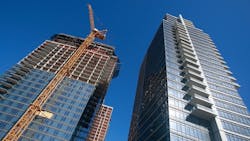Energy Department Invests $6 Million in Commercial-Building Efficiency
The U.S. Energy Department recently announced up to $6 million in funding for the deployment and demonstration of four emerging energy-saving technologies in commercial buildings across the country.
The projects will generate data, case studies, and information intended to help commercial-building owners adopt new energy-efficient technologies, including advanced ventilation, building-energy-use-optimization software, more efficient commercial refrigeration fan motors, and advanced lighting controls.
The funding recipients are:
- enVerid Systems of Houston, which will retrofit commercial-building ventilation systems with modules that remove pollutants such as carbon dioxide from indoor air, enabling the air to be recycled, greatly reducing the amount of outside air ventilated into the building, and reducing HVAC-system loads. Ten demonstrations will be conducted over three years.
- BuildingIQ Inc. of Foster City, Calif., which will optimize HVAC energy use across commercial buildings using Predictive Energy Optimization (PEO), a cloud-based software application that runs on top of existing building automation systems. PEO uses data from weather forecasts, utility tariffs, demand-response-event signals, and occupant schedules to automatically adjust energy-consuming building systems. These adjustments are based on building-specific modeling employing building-use data, predictive algorithms, and advanced control strategies. Sixteen demonstrations will be conducted.
- QM Power Inc. of Lee’s Summit, Mo., which will install and demonstrate approximately 12,000 high-efficiency 7- to 16-w fan motors it developed in more than 50 grocery stores throughout the United States, focusing on open-display-case retrofits. If fully adopted, the motor application has the potential to achieve more than 0.6 quad in energy savings and reduce energy costs by $1 billion.
- Northeast Energy Efficiency Partnerships of Lexington, Mass., which will demonstrate and evaluate two or more advanced-lighting-control (ALC) technologies in 10 buildings. Designers and installers will be trained to use the technologies, which turn off or dim lights when a space is not in use. The demonstration results will be used to support development of utility incentive programs to help further drive adoption of ALC technologies.
Last year, commercial buildings consumed about 20 percent of all energy used in the United States at an estimated cost of nearly $180 billion. They are responsible for 18 percent of total U.S. carbon emissions.
About the Author
Scott Arnold
Executive Editor
Described by a colleague as "a cyborg ... requir(ing) virtually no sleep, no time off, and bland nourishment that can be consumed while at his desk" who was sent "back from the future not to terminate anyone, but with the prime directive 'to edit dry technical copy' in order to save the world at a later date," Scott Arnold joined the editorial staff of HPAC Engineering in 1999. Prior to that, he worked as an editor for daily newspapers and a specialty-publications company. He has a bachelor's degree in journalism from Kent State University.
